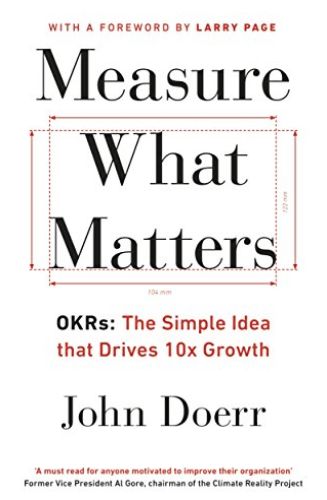John Doerr champions the Objectives and Key Results (OKR) process but warns that it works only in the right culture.

Measure Twice
Few authors can boast as much experience helping organizations as John Doerr. He worked in Silicon Valley with Intel and other firms before starting his career investing in and advising start-ups. He was an original investor in Google and Amazon and now chairs Kleiner Perkins, one of the largest, most respected venture capital firms. Doerr discovered, invested in and mentored outstanding leaders, including Bono of the Irish rock band U2 and tech pioneers Sergey Brin and Larry Page of Google.
At the dozens of companies that Doerr has funded and assisted, he evangelized for a process he learned from Andy Grove of Intel: Objectives and Key Results (OKRs). This is a simple method for choosing ambitious, inspiring goals and identifying the specific, measurable results needed to achieve them. OKRs rally employees and focus everyone on getting the necessary jobs done.
Ideas are easy. Execution is everything.John Doerr
Doerr’s engaging instruction and implementation manual includes dozens of examples and short case studies. He explains that your OKRs should state what your firm needs to achieve and then should clearly convey how that will come about. Reviewers and his peers welcomed his approach. Jim Collins, author of Good to Great, said Doerr’s book, “deserves to be fully embraced by every person responsible for performance, in any walk of life. John Doerr makes Andy Grove a mentor to us all.” Author Sheryl Sandberg explains, “Doerr has taught a generation of entrepreneurs and philanthropists that execution is everything. Measure What Matters shows how any organization or team can aim high, move fast and excel.”
Keep It Simple
Doerr, who has long experience crafting OKRs, advises firms to keep their OKRs simple and easily understood. He stresses creating only a few primary targets. When Doerr was at Intel, a typical OKR plan would first phrase an objective, such as, “Show that the X Intel chip exceeds the performance of the Y competitor chip.” Then it would list desired key results, such as setting five measures by which the Intel chip outperforms the competition, creating a demo, preparing material to train salespeople and having successful outcomes with at least three customers.
Doerr insists that to make this practice meaningful, everyone must participate. Every leader, manager and employee should create individual OKRs that align with the firm’s overarching OKRs. This could take months, Doerr warns, so persevere. People must document and share their OKRs, so everyone sees everyone else’s up and down the ladder. Each objective should have three to five KRs, and every employee’s objectives should include a personal stretch.
Doerr believes that when an organization makes its goals and progress visible to everyone, people work harder and collaborate more. He advises against the traditional top-down “cascading goals” approach, which might produce perfect alignment but lacks flexibility.
A healthy OKR environment strikes a balance between alignment and autonomy, common purpose and creative latitude.John Doerr
Doerr maintains that OKRs work because they incorporate specific hard goals. He notes that the business literature points to the OKR method as a robust forecast of success. People tend to rally around “audacious” goals – to use a Jim Collins term – more than modest ones. Stretch goals lead to innovation and breakthroughs.
For example, Doerr describes how leaders at Google typically strive for a ten-times (“10x”) or better improvement over whatever a project aims to replace or compete against. Gmail launched with a free gigabyte of storage per user, hundreds of times more storage than other cloud-based email services offered. Google fails at many big goals, but some turn into billion-dollar businesses.
Critical Objectives
Doerr advises leaders to strategize about their organization’s main goals and set other ideas aside. Choose corporate-level OKRs carefully to signal their importance. Align them with your organizational values, mission and purpose. While you must take your OKRs seriously, Doerr urges you to remember that they aren’t sculpted in marble, so adjust them as needed. Once the firm selects its OKRs, leaders must commit to, evangelize and model them. Make sure everyone understands them clearly and knows why they were chosen. Repeat the OKR message often.
Tracking Progress
In large organizations, tracking OKRs is challenging, so Doerr advises big companies to adopt OKR management platforms to record, track and align OKRs, even across tens of thousands of employees all pursuing shifting individual goals.
Doerr urges leaders to hold all employees – including executives – accountable for posting their OKRs and reporting on their progress at least quarterly. Make it clear that people can adjust, refine and even abandon OKRs that no longer serve their purposes. Adopt a way to score individuals’ progress against OKRs.
OKRs push us far beyond our comfort zones. They lead us to achievements on the border between abilities and dreams.John Doerr
At Intel, people and teams rate their KRs from 0% to 100% complete. A score of 70% to 100% means accomplished, while 40% to 60% shows progress being made. Anything less than 40% signals a failure. Intel sets aggressive goals and believes achieving 65% to 70% overall against KRs means good progress. For Grove, percentages that run too much higher signal that the goals weren’t aggressive enough.
Bill Gates would agree. Ambitious goal-setting and careful tracking were part of Microsoft from the very beginning. This mind-set carried over into the Bill and Melinda Gates Foundation, where OKRs became the daily language. Doerr explains that this enabled Gates to understand and track the Foundation’s progress efficiently. Gates’ insistence on OKRs helps the Foundation pursue its enormous goals, such as the complete elimination of malaria by 2040.
“Conversations, Feedback and Recognition”
Doerr frequently reminds you not to expect OKRs to work magic by themselves. Pair them with regular CFRs, in manager-to-staff and peer-to-peer sessions. Managers who conduct regular team meetings about performance stay aware of their employees’ needs and concerns. They can provide more frequent, timely and meaningful feedback and coaching. It’s circular, Doerr explains: Ongoing discussions fuel OKRs, and OKRs fuel ongoing discussion.
Five Crucial Questions
In your conversations with team members about their OKRs, Doerr advises you to ask five questions: What are you working on? What progress are you making on your OKRs? What, if any, obstacles do you face? How can I help? How do you need to grow to achieve your career objectives?
Doerr warns you to avoid talk of raises, promotions or rewards. Save those hot button subjects for separate discussions, so you don’t distract from the OKR process with emotionally charged matters like compensation. Listen more than you talk. Ask questions, provide specific feedback and coach, but don’t dominate or assign work or tasks. Get your employees involved in providing peer feedback and recognition. He promises that these simple changes boost engagement and retention, because people experience a greater sense of support and appreciation.
Strong culture
Doerr asserts that OKRs work only when paired with sound rewards and feedback. And, he warns, your efforts are likely to die on the vine if you don’t have the necessary cultural environment. Culture fuels success, perhaps more than anything else. OKRs drive organizations toward the right culture, including increased openness, responsibility, recognition, collaboration, trust, risk-taking and innovation. Sound OKRs also nurture learning, frank discussions and autonomy with accountability: the ingredients of a powerful, modern corporate culture.
OKRs are not a silver bullet. They cannot substitute for sound judgment, strong leadership or a creative workplace culture. But if those fundamentals are in place, OKRs can guide you to the mountaintop.John Doerr
To create and keep a strong talent culture, Doerr advises you to act quickly on employee issues, and monitor employee sentiment through robust CFRs that feature social platforms and tools that connect employees. Stay on top of anything that might cause disengagement. Culture is your firm’s single greatest differentiator and, Doerr says, the most crucial way to protect your success from easy imitation. Use OKRs and CFRs to create and sustain a flat, open, autonomous, accountable and collaborative culture.
Voice of Experience
Doerr’s guidance and methods will pay off for just about anyone in any organization – especially leaders. No one aware of his history and foresight would ever take his advice lightly. Doerr backs up his impressive experience with clear, simple, readable prose. He never drifts into jargon or corporate speak. As an author, he comes off much as you might suspect he does as an investor: tough, innovative, flexible and imbued with unusual common sense. He may not have the lightest, most varied prose style, but he understands precisely what he is trying to impart. His primary goal is making sure that you understand it, too.






